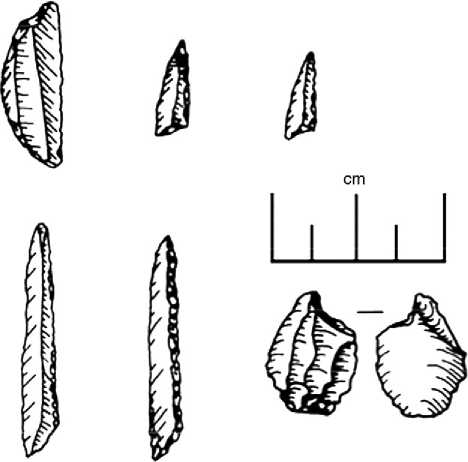Although archaeological research here also began more than 70 years ago, the Epipalaeolithic in eastern West Asia is poorly known due to historical events that have precluded extended periods of research. The main archaeological culture is the Zarzian, while the M’lefaatian is likely proto-Neolithic or Early Neolithic.
Zarzian Complex
Hunter-gatherer groups manufacturing backed micro-liths in the Zagros region are classified as Zarzian (Figure 7). As in the Levant, the Zarzian Complex has a temporal trend from nongeometric to geometric microliths (mainly scalene triangles). It also parallels the western Levant in that microburin technique appears when geometric microliths are manufactured. Due to the paucity of radiocarbon dates (see Carbon-14 Dating), currently it is not possible to delineate precisely when this change occured (see Table 1).
Most test excavated sites are rockshelters or caves in the mountainous foothills (Figure 8), such as Warwasi Rockshelter. All appear to represent highly mobile groups of hunter-gatherers pursing game animals such as onager, goat, red deer, aurochs, gazelle, and wild boar. Aside from repeated visits to these sites, there is no evidence for hut structures, burials, or investment in plant-processing tools such as ground stone. The duration of the Zarzian Complex is

Figure 7 Zarzian Complex. Top: lunate and small scalene triangles; bottom: elongated scalene triangles on left and microburin on right. Courtesy of Deborah I. Olszewski.
Thought to be from the onset of the LGM through the early part of the subsequent climatic amelioration. An end date of about 12 000 uncal BP is suggested by radiocarbon dates from Palegawra.
M’lefaatian Complex
The M’lefaatian Complex may derive from the Zar-zian, and several researchers classify the M’lefaatian as proto-Neolithic or Early Neolithic rather than Epi-palaeolithic. Hindering understanding is a 3000 year gap between the end of the Zarzian and the beginning of the M’lefaatian, during which there is little archaeological evidence. The M’lefaatian lithic industry contains nongeometric microliths and a well-developed technology that results in relatively standardized bladelet cores. Compared to the Zarzian Complex, M’lefaatian sites tend to be open-air contexts, such as M’lefaat, rather than caves and rockshelters.
Reliance on wild food resources was the norm, with hunting of cattle, sheep, gazelle, wild boar, birds, and the collection of freshwater clams, freshwater crabs, land snails, and fish. It is assumed that wild cereals formed part of the diet.




 World History
World History





![Stalingrad: The Most Vicious Battle of the War [History of the Second World War 38]](/uploads/posts/2015-05/1432581864_1425486471_part-38.jpeg)



